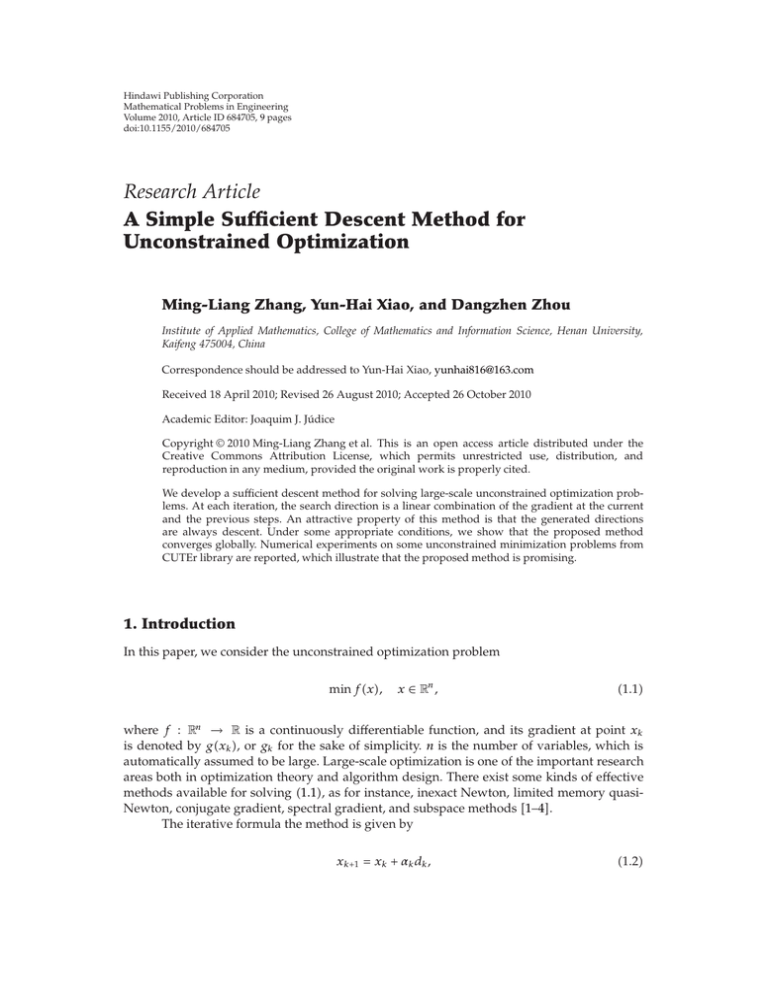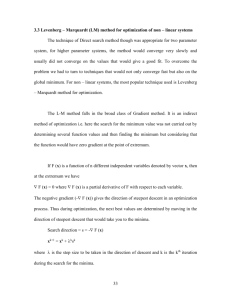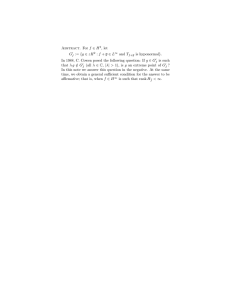Document 10948200
advertisement

Hindawi Publishing Corporation
Mathematical Problems in Engineering
Volume 2010, Article ID 684705, 9 pages
doi:10.1155/2010/684705
Research Article
A Simple Sufficient Descent Method for
Unconstrained Optimization
Ming-Liang Zhang, Yun-Hai Xiao, and Dangzhen Zhou
Institute of Applied Mathematics, College of Mathematics and Information Science, Henan University,
Kaifeng 475004, China
Correspondence should be addressed to Yun-Hai Xiao, yunhai816@163.com
Received 18 April 2010; Revised 26 August 2010; Accepted 26 October 2010
Academic Editor: Joaquim J. Júdice
Copyright q 2010 Ming-Liang Zhang et al. This is an open access article distributed under the
Creative Commons Attribution License, which permits unrestricted use, distribution, and
reproduction in any medium, provided the original work is properly cited.
We develop a sufficient descent method for solving large-scale unconstrained optimization problems. At each iteration, the search direction is a linear combination of the gradient at the current
and the previous steps. An attractive property of this method is that the generated directions
are always descent. Under some appropriate conditions, we show that the proposed method
converges globally. Numerical experiments on some unconstrained minimization problems from
CUTEr library are reported, which illustrate that the proposed method is promising.
1. Introduction
In this paper, we consider the unconstrained optimization problem
min fx,
x ∈ Ên ,
1.1
where f : Ên → Ê is a continuously differentiable function, and its gradient at point xk
is denoted by gxk , or gk for the sake of simplicity. n is the number of variables, which is
automatically assumed to be large. Large-scale optimization is one of the important research
areas both in optimization theory and algorithm design. There exist some kinds of effective
methods available for solving 1.1, as for instance, inexact Newton, limited memory quasiNewton, conjugate gradient, spectral gradient, and subspace methods 1–4.
The iterative formula the method is given by
xk1 xk αk dk ,
1.2
2
Mathematical Problems in Engineering
where αk is a steplength, and dk is a search direction. Generally, we say that dk is a descent
direction of f at xk if dk gk < 0. Furthermore, if there exists a positive constant C > 0 such that
dk gk ≤ −Cgk 2 , then dk is often called a sufficient descent direction. The descent property is
very important for the iterative method to be global convergent, especially for the conjugate
gradient method 5. Unfortunately, for the earliest spectral gradient method 6 and the PRP
conjugated gradient method, their generated directions are not always descent. Therefore, in
the last years, much effort has been done to smooth away the drawback and develop new
methods, for example, 7.
As is wellknown, if Armijo line search is used, the standard PRP method can cycle
infinitely without approaching any optimal point when solving nonconvex minimization
problems. To overcome this drawback, Hager and Zhang 8 made a slight modification on
the PRP formula. Consequently, the resulting method own the remarkable property: for any
line search, the generated direction always satisfies the sufficient descent condition dk gk ≤
−7/8gk 2 . Moreover, Zhang et al. 9 further studied the PRP formula and proposed a
three-term modified PRP method, in which the generated directions satisfy
2
dk gk −gk ,
1.3
and this property is independent of any line search. Additionally, for improving the
numerical performance of the standard FR method, Zhang et al. 10 developed a modified
FR method where the direction also satisfy 1.3.
Although much progress has been made in designing a sufficient descent direction
in a conjugate gradient method, it seemingly receive little attention in other methods. Very
recently, An et al. 5 proposed a robust technique to construct a sufficient descent direction
for unconstrained optimization. The descent direction is a linear combination of the steepest
descent direction and the projection of the original direction, that is,
dk −gk λk
gk g I − k2
g k dk ,
1.4
where λk is a scalar and dk is an original direction. Based on the definition of dk , it is easy
to deduce that the sufficient descent condition 1.3 holds. This technique has been applied
to the PSB updated formula and showed that the resulting method converges globally and
superlinearly for an uniformly convex function. Moreover, the direction in 11 is truly a
special case of 1.4.
We note that 1.4 can be considered as a general form of a nonlinear conjugate
gradient method, in which
dk −gk βk dk−1 ,
1.5
where βk is a scalar. Comparing with 1.4, we see that the scalar βk takes the place of the
coefficient matrix of dk . In this paper, we further study the sufficient descent technique
1.4, and propose a simple sufficient descent method for solving unconstrained optimization
problems. Our motivation is simple, we choose dk as the gradient of the previous step in 1.4.
The search direction in this proposed method always satisfies a sufficient descent condition.
Mathematical Problems in Engineering
3
Under some conditions, we show that the algorithm converges globally by using a special
line search. The performance of the method on some CUTEr test problems indicates that it is
encouraging.
We organize this paper as follows. In the next section, we construct the sufficient
descent direction. In Section 3, we state the steps of our new algorithm with a special line
search. We also report some experiments on some large-scale unconstrained optimization
problems. Finally, we conclude this paper with some remarks in the last section. Throughout
this paper, the symbol · denotes the Euclidean norm of a vector.
2. New Search Direction
This section aims to state the new direction formula and investigate its properties. Now, if we
take gk−1 as dk and set λk ≡ 1 in 1.4, we get
dk −gk gk g I − k2
g k gk−1 .
2.1
Obviously, the direction is a linear combination of the gradient at the current and the previous
steps. Additionally, to obtain the global convergence of PRP method, Cheng 11 introduced
a descent direction defined as
dk −gk βkPRP
gk g I − k2
g k dk−1 .
2.2
We note that 2.2 is only a special choice of 1.4, in which dk is replaced by dk−1 and λk is
chosen as the scalar βkPRP . If we denote
gk g Hk I − k2 ,
g k 2.3
then it is easy to see that for any y /
0, we have
2
y Hk y y Hk Hk y Hk y ≥ 0,
2.4
which indicates that Hk is a symmetric and positive semidefinite matrix.
3. Sufficient Descent Method
As we have stated in the previous section, the directions in 2.1 satisfy a sufficient descent
condition. In this section, we list our algorithm and establish its global convergence.
Firstly, we state the steps of the simple sufficient descent method. In order to
achieve the global convergence of our method, we consider the backtracking line search of
4
Mathematical Problems in Engineering
Grippo and Lucidi GL 12. That is, for given δ ∈ 0, 1, β > 0, ρ ∈ 0, 1, find the first jk
j 1, 2, . . . such that αk βρjk satisfies
fxk αk dk ≤ fxk − δα2k dk 2 .
3.1
Now, we are ready to state the steps of the Simple Sufficient Descent SSD method.
Algorithm 3.1 SSD. We have the following steps.
Step 1. Given x0 ∈ Ên . Let 0 < δ < 1, and d0 −g0 . Set k : 0.
Step 2. If gk 0, then stop.
Step 3. Compute dk by 2.1.
Step 4. Find the steplength αk satisfying 3.1. Let xk1 xk αk dk .
Step 5. Set k : k 1, go to Step 2.
The remainder of this section is devoted to investigate the global convergence of
Algorithm 3.1. We first state some assumptions.
Assumption 3.2. Function f is continuously differentiable and the level set F {x ∈
fx ≤ fx0 } is bounded.
Ên
|
Assumption 3.3. The gradient of f is Lipschitz continuous, that is, there exists a constant L > 0
such that
gx − g y ≤ Lx − y,
∀x, y ∈ Ên .
3.2
We first prove the following lemma.
Lemma 3.4. Let the sequence {xk } be generated by Algorithm 3.1. Suppose that Assumptions 3.2 and
3.3 hold. Then,
∞ g 2
k
k0
dk 2
< ∞.
3.3
Proof. We have the following cases.
Case 1. Consider firstly the GL line search 3.1. If αk /
β, then ρ−1 αk may not satisfy 3.1.
That is,
f xk ρ−1 αk dk > fxk − δρ−2 α2k dk 2 .
3.4
Mathematical Problems in Engineering
5
By the mean value theorem and Assumption 3.3, there exists θk ∈ 0, 1 such that
f xk ρ−1 αk dk − fxk ρ−1 αk g xk θk ρ−1 αk dk dk
ρ−1 αk gk dk ρ−1 αk g xk θk ρ−1 αk dk − gk dk
3.5
≤ ρ−1 αk gk dk Lρ−2 α2k dk 2 ,
where L > 0 is the Lipschitz constant of g. Substituting the last inequality into 3.4, we get
2
2
g k g k 1
c1
.
αk ≥ − −1
2
ρ L δ dk dk 2
3.6
This implies that there is a constant M > 0 such that
4
g k ≤ M fxk − fxk1 .
3.7
2
≤ gk ≤ dk 2 ≤ δ−1 β−2 fxk − fxk−1 ,
3.8
dk 2
Case 2. If α β, then we have
4
g k dk 2
which shows that 3.7 holds with M δ−1 β−2 . Moreover, 3.7 indicates the lemma claims.
Theorem 3.5. Let {xk } be generated by Algorithm 3.1 with GL backtracking line search 3.1. Then
lim infgk 0.
k→∞
3.9
Proof. From Assumption 3.3, we know that there exists a positive constant γ such that
gk ≤ γ .
3.10
dk ≤ gk Hk gk−1 ≤ gk gk−1 ≤ 2γ,
3.11
By the definition of dk in 2.1, we have
which shows that dk is bounded. We get from 3.1 that
∞
α2k dk 2 < ∞.
k0
3.12
6
Mathematical Problems in Engineering
Consequently, we have
lim αk dk 0.
k→∞
3.13
For the sake of contradiction, we suppose that 3.9 does not hold. Then there is a constant
> 0 such that gk ≥ for all k ≥ 0.
If lim infk → ∞ αk > 0, we get from 3.13 that lim infk → ∞ dk 0, which shows
lim infk → ∞ gk 0. This contradicts the assumption 3.9.
If lim infk → ∞ αk 0, that is, there is an infinite index set K such that
lim
k∈K,k → ∞
αk 0.
3.14
It follows from the line search step in Algorithm 3.1 that when k ∈ K is sufficiently large,
ρ−1 αk does not satisfy 3.1. Then from the first part of the proof of Lemma 3.4 we see that
3.6 holds. Since dk is bounded and limk∈K,k → ∞ αk 0, 3.6 implies lim infk → ∞ gk 0.
This also yields a contradiction. The proof is complete.
4. Numerical Results
In this section, we test the feasibility and effectiveness of the Algorithm SSD. The algorithm
is implemented in Fortran77 code using double precision arithmetic. All runs are performed
on a PC Intel Pentium Dual E2140 1.6 GHz, 256 MB SDRAM with Linux operations system.
The algorithm stops if the infinity-norm of the final gradient is below 10−5 , that is
∇fx ≤ 10−5 .
4.1
The iteration is also stopped if the number of iterations exceeds 10000 or the number of
function evaluations reaches 20000. Our experiments are performed on the subset of the
nonlinear unconstrained problems from CUTEr 13 collection. The second-order derivatives
of all the selected problems are available. Since we are interested in large problems, we refined
this selection by considering only problems where the number of variables is at least 50. The
parameter in line search 3.1 is taken as: β 1, ρ 0.1, and δ 10−4 . The numerical results
of the algorithms SSD are listed in Table 1. The columns have the following meanings:
Problem: name of the test problem,
Dim: dimension of the test problem,
Iter: number of iterations,
Nf: number of function evaluations,
Time: CPU time in seconds,
Fv: final function value,
Norm-2: l2 -norm of the final gradient, and
Norm-0: ∞-norm of the final gradient.
Mathematical Problems in Engineering
7
Table 1: Test results for SSD method.
Problem
ARGLINA
ARWHEAD
BROWNAL
BROYDN7D
BRYBND
DIXMAANA
DIXMAANB
DIXMAANC
DIXMAAND
QDRTIC
DQRTIC
EDENSCH
ENGVAL1
FLETCBV2
MANCINO
QUARTC
SCHMVETT
SENSORS
SPMSRTLS
TOINTGSS
VARDIM
VAREIGVL
EG2
MOREBV
TOINTGOR
TOINTQOR
Dim
200
5000
200
5000
5000
3000
3000
3000
3000
5000
5000
2000
5000
5000
100
5000
5000
100
4999
5000
200
50
1000
5000
50
50
Iter
2
12
3175
5986
105
140
130
120
139
1095
196
87
70
0
26
196
255
56
3489
91
1
67
4
172
1432
247
Nf
3
34
5126
9664
160
190
179
166
188
1757
282
136
120
1
56
282
386
184
5629
132
2
106
5
279
2303
376
Time
0.01
0.03
1.40
20.09
0.28
0.11
0.10
0.10
0.11
1.72
0.11
0.06
0.12
0.00
0.71
0.11
1.12
0.85
8.74
0.11
0.00
0.00
0.00
0.22
0.02
0.00
Fv
0.2000000E 03
0.5550005E − 12
0.1475222E − 08
0.1815779E 04
0.3534654E − 11
0.1000000E 01
0.1000000E 01
0.1000000E 01
0.1000000E 01
0.2290216E − 10
0.3480734E − 06
0.1200328E 05
0.5548668E 04
−0.5002682E 00
0.3102390E − 17
0.3480734E − 06
−0.1499400E 05
−0.2101781E 04
0.1833147E − 08
0.1000400E 02
0.1479114E − 30
0.1042896E − 10
−0.9989474E 03
0.1462269E − 08
0.1373905E 04
0.1175472E 04
Norm-2
0.15350E − 12
0.80345E − 05
0.29801E − 05
0.17731E − 05
0.29153E − 05
0.24750E − 06
0.30449E − 06
0.10046E − 05
0.15385E − 05
0.95704E − 05
0.68218E − 06
0.38002E − 05
0.37840E − 05
0.79960E − 07
0.91840E − 06
0.68218E − 06
0.68017E − 05
0.46106E − 05
0.90139E − 05
0.76757E − 05
0.44409E − 15
0.38234E − 05
0.13514E − 05
0.42417E − 05
0.49818E − 05
0.55492E − 05
Norm-0
0.28232E − 23
0.89063E − 10
0.93967E − 10
0.20076E − 10
0.29287E − 10
0.93362E − 10
0.61730E − 10
0.86335E − 10
0.77064E − 10
0.94807E − 10
0.46755E − 10
0.97655E − 10
0.82778E − 10
0.19455E − 10
0.23394E − 10
0.46755E − 10
0.67249E − 10
0.35706E − 10
0.96204E − 10
0.60378E − 10
0.59165E − 30
0.87845E − 10
0.18263E − 11
0.88342E − 10
0.88106E − 10
0.88045E − 10
In addition, we also present extensive numerical results of the state-of-the-art
algorithm CG DESCENT 8, 14. CG DESCENT is a conjugate gradient descent method for
solving large-scale unconstrained optimization problems. A new nonmonotone line search
were used in CG DESCENT which makes this algorithm very efficient. The Fortran code
can be obtained from http://www.math.ufl.edu/∼hager/. When running of CG DESCENT,
default values are used for all parameters. The results are summarized in Table 2.
Observing the tables, we see that SSD works well, as it reached a stationary point based
on the stopping criterion 4.1 for almost all these test problems. Although SSD requires large
number of iterations or function evaluations, it needs less time consuming comparatively.
However, the numerical comparisons tell us that the state-of-the-art algorithm CG DESCENT
performs a little better than SSD, but for some specific problems, the enhancement of SSD is
still noticeable. The numerical experiments also show that SSD can potentially used to solve
unconstrained optimization problems with higher dimensions.
5. Concluding Remarks
In this paper, motivated by a descent technique, we have proposed a simple sufficient descent
method for solving large-scale unconstrained optimization problems. At each iteration, the
generated directions are only related to the gradient information of two successive points.
8
Mathematical Problems in Engineering
Table 2: Test results for CG DESCENT.
Problem
ARGLINA
ARWHEAD
BROWNAL
BROYDN7D
BRYBND
DIXMAANA
DIXMAANB
DIXMAANC
DIXMAAND
DQDRTIC
DQRTIC
EDENSCH
ENGVAL1
FLETCBV2
MANCINO
QUARTC
SCHMVETT
SENSORS
SPMSRTLS
TOINTGSS
VARDIM
VAREIGVL
EG2
MOREBV
TOINTGOR
TOINTQOR
Dim
200
5000
200
5000
5000
3000
3000
3000
3000
5000
5000
2000
5000
5000
100
5000
5000
100
4999
5000
200
50
1000
5000
50
50
Iter
1
9
4
1444
31
8
9
10
11
7
32
29
23
0
11
32
35
23
186
3
28
52
3
32
107
28
Nf
3
19
15
2885
64
17
19
21
23
15
65
56
45
1
23
65
63
55
379
7
57
142
7
65
206
55
Ng
2
12
13
1453
34
9
10
11
12
8
33
33
32
1
12
33
46
40
195
4
29
90
4
34
121
31
Time
0.01
0.02
0.01
5.13
0.10
0.01
0.00
0.01
0.01
0.02
0.02
0.02
0.05
0.01
0.30
0.02
0.19
0.19
0.51
0.01
0.00
0.00
0.00
0.04
0.00
0.00
Fv
0.20000E 03
0.00000E 00
0.14731E − 08
0.19785E 04
0.14292E − 10
0.10000E 01
0.10000E 01
0.10000E 01
0.10000E 01
0.41826E − 14
0.28560E − 04
0.12003E 05
0.55487E 04
−0.50027E 00
0.20215E − 17
0.28560E − 04
−0.14994E 05
−0.21085E 04
0.19502E − 08
0.10002E 02
0.27052E − 22
0.40508E − 10
−0.99895E 03
0.10103E − 08
0.13739E 04
0.11755E 04
Norm-2
0.21133E − 06
0.83931E − 06
0.11790E − 05
0.68854E − 05
0.65055E − 05
0.15586E − 05
0.35546E − 06
0.70236E − 06
0.32593E − 05
0.18957E − 06
0.30250E − 05
0.74432E − 05
0.53164E − 05
0.79960E − 07
0.97074E − 06
0.30250E − 05
0.90275E − 05
0.29929E − 05
0.82452E − 05
0.60471E − 05
0.20805E − 08
0.71079E − 05
0.81318E − 05
0.89736E − 05
0.88894E − 05
0.49970E − 05
Under some mild conditions, we have shown that this method is global convergent. The
numerical results indicate that it works well on some selected problems from CUTEr library.
We think there are several other issues that could be lead to improvements. A first point
that should be considered is probably the choice of a nonmonotone line search technique.
We have adopted the monotone scheme of Grippo and Lucidi 3.1, but this is not the only
possible choice, and the framework developed in 15, 16 may allow one to achieve a better
performance. Similar to 5, another important point that should be further investigated is a
modification of the search direction without violating the nice sufficient descent property. To
this end, it is interesting to note that this method is capable of solving nonlinear systems of
equations without Jacobian information and cheaply computing.
Acknowledgments
The authors thank Professor Zengxin Wei of Guangxi University for his careful reading. The
authors are also grateful two anonymous referees for their useful comments and suggestions
to improve the paper. The work is supported by the Chinese Postdoctoral Foundation Grant
no. 20090461094, the Natural Science Foundation of China Grant no. 11001075, the Natural
Science Foundation of Henan Province Eduction Department Grant no. 2010B110004.
Mathematical Problems in Engineering
9
References
1 J. Nocedal and S. J. Wright, Numerical Optimization, Springer Series in Operations Research, Springer,
New York, NY, USA, 1999.
2 M. Raydan, “The Barzilai and Borwein gradient method for the large scale unconstrained
minimization problem,” SIAM Journal on Optimization, vol. 7, no. 1, pp. 26–33, 1997.
3 Y. Xiao, Z. Wei, and Z. Wang, “A limited memory BFGS-type method for large-scale unconstrained
optimization,” Computers & Mathematics with Applications, vol. 56, no. 4, pp. 1001–1009, 2008.
4 Y. Yuan, “Subspace techniques for nonlinear optimization,” in Some Topics in Industrial and Applied
Mathematics, R. Jeltsch, D. Q. Li, and I. H. Sloan, Eds., vol. 8 of Series in Contemporary Applied
Mathematics, pp. 206–218, Higher Education Press, Beijing, China, 2007.
5 X.-M. An, D.-H. Li, and Y. Xiao, “Sufficient descent directions in unconstrained optimization,”
Computational Optimization and Applications. In press.
6 J. Barzilai and J. M. Borwein, “Two-point step size gradient methods,” IMA Journal of Numerical
Analysis, vol. 8, no. 1, pp. 141–148, 1988.
7 J. Zhang, Y. Xiao, and Z. Wei, “Nonlinear conjugate gradient methods with sufficient descent
condition for large-scale unconstrained optimization,” Mathematical Problems in Engineering, vol. 2009,
Article ID 243290, 16 pages, 2009.
8 W. W. Hager and H. Zhang, “A new conjugate gradient method with guaranteed descent and an
efficient line search,” SIAM Journal on Optimization, vol. 16, no. 1, pp. 170–192, 2005.
9 L. Zhang, W. Zhou, and D.-H. Li, “A descent modified Polak-Ribière-Polyak conjugate gradient
method and its global convergence,” IMA Journal of Numerical Analysis, vol. 26, no. 4, pp. 629–640,
2006.
10 L. Zhang, W. Zhou, and D. Li, “Global convergence of a modified Fletcher-Reeves conjugate gradient
method with Armijo-type line search,” Numerische Mathematik, vol. 104, no. 4, pp. 561–572, 2006.
11 W. Cheng, “A two-term PRP-based descent method,” Numerical Functional Analysis and Optimization,
vol. 28, no. 11-12, pp. 1217–1230, 2007.
12 L. Grippo and S. Lucidi, “A globally convergent version of the Polak-Ribière conjugate gradient
method,” Mathematical Programming, vol. 78, no. 3, pp. 375–391, 1997.
13 I. Bongartz, A. R. Conn, N. Gould, and P. L. Toint, “CUTE: constrained and unconstrained testing
environment,” ACM Transactions on Mathematical Software, vol. 21, no. 1, pp. 123–160, 1995.
14 W. W. Hager and H. Zhang, “Algorithm 851: CG DESCENT, a conjugate gradient method with
guaranteed descent,” ACM Transactions on Mathematical Software, vol. 32, no. 1, pp. 113–137, 2006.
15 L. Grippo, F. Lampariello, and S. Lucidi, “A nonmonotone line search technique for Newton’s
method,” SIAM Journal on Numerical Analysis, vol. 23, no. 4, pp. 707–716, 1986.
16 H. Zhang and W. W. Hager, “A nonmonotone line search technique and its application to
unconstrained optimization,” SIAM Journal on Optimization, vol. 14, no. 4, pp. 1043–1056, 2004.





